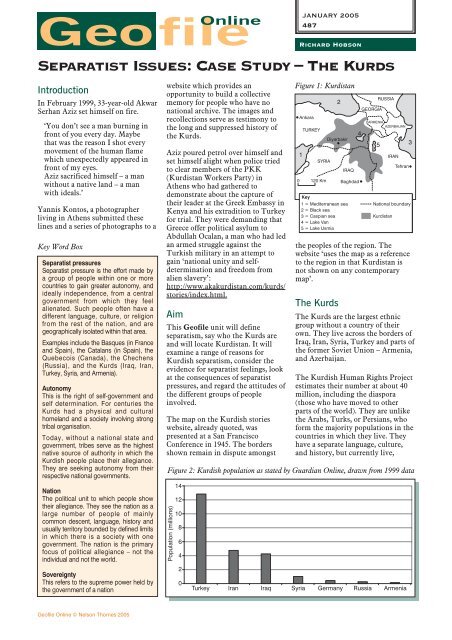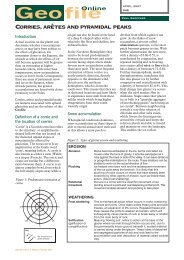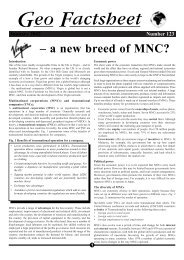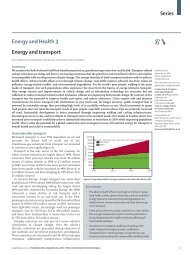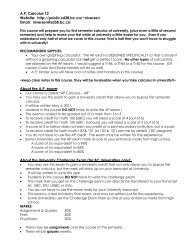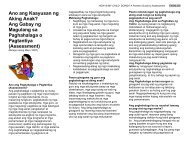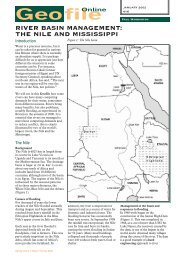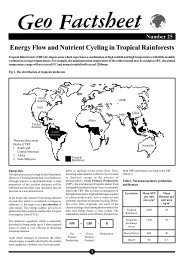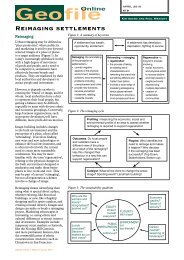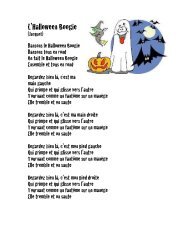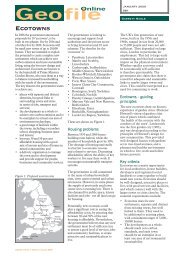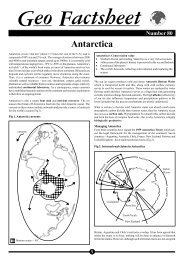Separatist Issues: Case Study â The Kurds - School-Portal.co.uk
Separatist Issues: Case Study â The Kurds - School-Portal.co.uk
Separatist Issues: Case Study â The Kurds - School-Portal.co.uk
Create successful ePaper yourself
Turn your PDF publications into a flip-book with our unique Google optimized e-Paper software.
Geofile<br />
Online<br />
Introduction<br />
In February 1999, 33-year-old Akwar<br />
Serhan Aziz set himself on fire.<br />
‘You don’t see a man burning in<br />
front of you every day. Maybe<br />
that was the reason I shot every<br />
movement of the human flame<br />
which unexpectedly appeared in<br />
front of my eyes.<br />
Aziz sacrificed himself – a man<br />
without a native land – a man<br />
with ideals.’<br />
Yannis Kontos, a photographer<br />
living in Athens submitted these<br />
lines and a series of photographs to a<br />
website which provides an<br />
opportunity to build a <strong>co</strong>llective<br />
memory for people who have no<br />
national archive. <strong>The</strong> images and<br />
re<strong>co</strong>llections serve as testimony to<br />
the long and suppressed history of<br />
the <strong>Kurds</strong>.<br />
Aziz poured petrol over himself and<br />
set himself alight when police tried<br />
to clear members of the PKK<br />
(Kurdistan Workers Party) in<br />
Athens who had gathered to<br />
demonstrate about the capture of<br />
their leader at the Greek Embassy in<br />
Kenya and his extradition to Turkey<br />
for trial. <strong>The</strong>y were demanding that<br />
Greece offer political asylum to<br />
Abdullah Ocalan, a man who had led<br />
an armed struggle against the<br />
Turkish military in an attempt to<br />
gain ‘national unity and selfdetermination<br />
and freedom from<br />
alien slavery’:<br />
http://www.akakurdistan.<strong>co</strong>m/kurds/<br />
stories/index.html.<br />
Aim<br />
This Geofile unit will define<br />
separatism, say who the <strong>Kurds</strong> are<br />
and will locate Kurdistan. It will<br />
examine a range of reasons for<br />
Kurdish separatism, <strong>co</strong>nsider the<br />
evidence for separatist feelings, look<br />
at the <strong>co</strong>nsequences of separatist<br />
pressures, and regard the attitudes of<br />
the different groups of people<br />
involved.<br />
<strong>The</strong> map on the Kurdish stories<br />
website, already quoted, was<br />
presented at a San Francis<strong>co</strong><br />
Conference in 1945. <strong>The</strong> borders<br />
shown remain in dispute amongst<br />
JANUARY 2005<br />
487<br />
Richard Hobson<br />
<strong>Separatist</strong> <strong>Issues</strong>: <strong>Case</strong> <strong>Study</strong> – <strong>The</strong> <strong>Kurds</strong><br />
Key Word Box<br />
<strong>Separatist</strong> pressures<br />
<strong>Separatist</strong> pressure is the effort made by<br />
a group of people within one or more<br />
<strong>co</strong>untries to gain greater autonomy, and<br />
ideally independence, from a central<br />
government from which they feel<br />
alienated. Such people often have a<br />
different language, culture, or religion<br />
from the rest of the nation, and are<br />
geographically isolated within that area.<br />
Examples include the Basques (in France<br />
and Spain), the Catalans (in Spain), the<br />
Quebe<strong>co</strong>is (Canada), the Chechens<br />
(Russia), and the <strong>Kurds</strong> (Iraq, Iran,<br />
Turkey, Syria, and Armenia).<br />
Autonomy<br />
This is the right of self-government and<br />
self determination. For centuries the<br />
<strong>Kurds</strong> had a physical and cultural<br />
homeland and a society involving strong<br />
tribal organisation.<br />
Today, without a national state and<br />
government, tribes serve as the highest<br />
native source of authority in which the<br />
Kurdish people place their allegiance.<br />
<strong>The</strong>y are seeking autonomy from their<br />
respective national governments.<br />
Nation<br />
<strong>The</strong> political unit to which people show<br />
their allegiance. <strong>The</strong>y see the nation as a<br />
large number of people of mainly<br />
<strong>co</strong>mmon descent, language, history and<br />
usually territory bounded by defined limits<br />
in which there is a society with one<br />
government. <strong>The</strong> nation is the primary<br />
focus of political allegiance – not the<br />
individual and not the world.<br />
Sovereignty<br />
This refers to the supreme power held by<br />
the government of a nation<br />
Ankara<br />
1<br />
TURKEY<br />
SYRIA<br />
0 120 Km<br />
the peoples of the region. <strong>The</strong><br />
website ‘uses the map as a reference<br />
to the region in that Kurdistan is<br />
not shown on any <strong>co</strong>ntemporary<br />
map’.<br />
<strong>The</strong> <strong>Kurds</strong><br />
2<br />
Diyarbakir<br />
IRAQ<br />
Key<br />
1 = Mediterranean sea<br />
2 = Black sea<br />
3 = Caspian sea<br />
4 = Lake Van<br />
5 = Lake Usmia<br />
Baghdad<br />
<strong>The</strong> <strong>Kurds</strong> are the largest ethnic<br />
group without a <strong>co</strong>untry of their<br />
own. <strong>The</strong>y live across the borders of<br />
Iraq, Iran, Syria, Turkey and parts of<br />
the former Soviet Union – Armenia,<br />
and Azerbaijan.<br />
<strong>The</strong> Kurdish Human Rights Project<br />
estimates their number at about 40<br />
million, including the diaspora<br />
(those who have moved to other<br />
parts of the world). <strong>The</strong>y are unlike<br />
the Arabs, Turks, or Persians, who<br />
form the majority populations in the<br />
<strong>co</strong>untries in which they live. <strong>The</strong>y<br />
have a separate language, culture,<br />
and history, but currently live,<br />
4<br />
GEORGIA<br />
RUSSIA<br />
ARMENIA<br />
AZERBAIJAN<br />
5<br />
IRAN<br />
Tehran<br />
3<br />
National boundary<br />
Kurdistan<br />
Figure 2: Kurdish population as stated by Guardian Online, drawn from 1999 data<br />
Population (millions)<br />
14<br />
12<br />
10<br />
8<br />
6<br />
4<br />
2<br />
0<br />
Figure 1: Kurdistan<br />
Turkey Iran Iraq Syria Germany Russia Armenia<br />
Geofile Online © Nelson Thornes 2005
January 2005 no.487 <strong>Separatist</strong> <strong>Issues</strong>: <strong>Case</strong> <strong>Study</strong> – <strong>The</strong> <strong>Kurds</strong><br />
Figure 3: Population trends among Kurdish populations<br />
Population (millions)<br />
Population (millions)<br />
100<br />
90<br />
80<br />
70<br />
60<br />
50<br />
40<br />
30<br />
20<br />
10<br />
0<br />
50<br />
40<br />
30<br />
20<br />
10<br />
0<br />
Total population of <strong>Kurds</strong> living in all <strong>co</strong>untries<br />
sometimes without re<strong>co</strong>gnition, in<br />
these <strong>co</strong>untries.<br />
<strong>The</strong>ir culture and identity have been<br />
oppressed by the regimes of the<br />
nations within which they live.<br />
Religion, language, culture and<br />
perhaps, most importantly, a<br />
<strong>co</strong>mmon history of persecution, tie<br />
together the more than 20 million<br />
<strong>Kurds</strong> worldwide.<br />
Kurdistan<br />
1990 2000 2020 2050<br />
Total population of <strong>Kurds</strong> living in individual <strong>co</strong>untries<br />
1990<br />
2000<br />
2200<br />
2500<br />
Total population of <strong>Kurds</strong> living<br />
in individual <strong>co</strong>untries<br />
CIS Iraq Iran Syria Turkey<br />
Source: http://www.xs4all.nl/~tank/kurdish/htdocs/facts/demographic.html<br />
Figure 4: Information to help locate Kurdistan<br />
Kurdistan is basically made up of<br />
the mountainous areas of the central<br />
and northern Zagros, the eastern<br />
third of the Taurus and the Pontus,<br />
and the northern half of the Amanus<br />
Population (millions)<br />
<strong>The</strong> total population living in<br />
individual <strong>co</strong>untries<br />
250<br />
1990<br />
2000<br />
200<br />
2200<br />
2500<br />
150<br />
100<br />
50<br />
0<br />
Percentage of <strong>Kurds</strong> living in individual<br />
<strong>co</strong>untries in 1990<br />
Iraq Iran Syria Turkey<br />
ranges. <strong>The</strong> relationship between the<br />
<strong>Kurds</strong> and their mountains is very<br />
strong – the <strong>Kurds</strong>’ home ends<br />
where the mountains end.<br />
<strong>The</strong>re are also two Kurdish enclaves<br />
in central and north central Anatolia<br />
in Turkey and in the province of<br />
Khurasan in north-east Iran.<br />
Language and Religion<br />
Iraq<br />
Iran<br />
Syria<br />
Turkey<br />
Information to help locate Kurdistan : Highest Points<br />
Area Mountain Country Height<br />
Southern Kurdistan Mt Alvand Iran 3,580 metres<br />
Central Kurdistan Mt Halgurd Iraq 3,733 metres<br />
Western Kurdistan Mt Munzur Turkey 3,840 metres<br />
Northern Kurdistan Mt Ararat Turkey 5,165 metres<br />
Information to help locate Kurdistan: Area<br />
Area<br />
Equivalent areas<br />
595,700 km 2 Germany and France Texas<br />
Britain<br />
Climate Information<br />
Rainfall<br />
Temperature<br />
1524–2032 mm per year in the Central Regions<br />
508–1016 mm per year on lower land<br />
Most precipitation is in the form snow, which can<br />
fall for six months of the year<br />
<strong>The</strong> mean average temperature is 13–18°C,<br />
decreasing with height<br />
<strong>The</strong> Kurdish language is part of the<br />
north-western subdivision of the<br />
Iranic branch of the Indo-European<br />
family of languages, which is like<br />
Persian, and by extension, related to<br />
the European languages. Modern<br />
Kurdish divides into Kurmanji and<br />
Dimili-Gurani, supplemented by<br />
s<strong>co</strong>res of sub-dialects. A modified<br />
version of the Perso- Arabic alphabet<br />
is used in Iraq and Iran. Elsewhere,<br />
the written language is based on the<br />
Cyrillic and Latin alphabets.<br />
Nearly three-fifths of the <strong>Kurds</strong> are<br />
Sunni Muslims; there are Shiite and<br />
Sufi Muslims too. <strong>The</strong>re are several<br />
indigenous Kurdish faiths of great<br />
age. Communities of Jews,<br />
Christians and Baha’is are found in<br />
various <strong>co</strong>rners of Kurdistan.<br />
Brief History<br />
Kurdish history can be even more<br />
subjective than most history – there<br />
are <strong>Kurds</strong>, nationalist governments<br />
and global powers like Britain,<br />
France and the United States of<br />
America telling the story. Here is<br />
some information to provide a<br />
historical background.<br />
<strong>The</strong>re has never been a re<strong>co</strong>gnised<br />
Kurdistan nation like there is a<br />
Turkish or Iraqi state. <strong>The</strong>re were<br />
only small kingdoms and tribes that<br />
were alternately united or at war<br />
over hundreds of years. <strong>The</strong> Middle<br />
East has always seen movements of<br />
people. In the 12th and 13 th<br />
centuries Turkish nomads<br />
dominated the area, and most<br />
independent Kurdish states<br />
succumbed. Kurdish principalities<br />
survived and were autonomous until<br />
the 17 th century. In the <strong>co</strong>urse of the<br />
16th to 18th centuries, vast portions<br />
of Kurdistan were systematically<br />
devastated by the Safavids and<br />
Ottomans. Large numbers of <strong>Kurds</strong><br />
were deported to far <strong>co</strong>rners of their<br />
empires. <strong>The</strong> scale of this death and<br />
destruction was the basis for a<br />
unification of feeling against foreign<br />
vandals. <strong>The</strong>re was a call for a united<br />
Kurdish state; and the fostering of<br />
culture and language. <strong>The</strong>se feelings<br />
were expressed in the literature of<br />
the time. By 1867 the last<br />
autonomous principalities had been<br />
eradicated by the Ottoman and<br />
Persian governments that ruled<br />
Kurdistan. <strong>The</strong> Kurdish provinces<br />
were under the <strong>co</strong>ntrol of governors.<br />
<strong>The</strong> break-up of the Ottoman<br />
Empire at the end of the First World<br />
War made matters worse. <strong>The</strong><br />
Treaty of Sevres in 1921 imagined<br />
an independent Kurdish state<br />
<strong>co</strong>vering large portions of Ottoman<br />
Kurdistan – guaranteeing selfdetermination<br />
to the <strong>Kurds</strong>.<br />
However, Britain and France had<br />
Geofile Online © Nelson Thornes 2005
January 2005 no.487 <strong>Separatist</strong> <strong>Issues</strong>: <strong>Case</strong> <strong>Study</strong> – <strong>The</strong> <strong>Kurds</strong><br />
Figure 5: Examples of states protecting their boundaries and threatening Kurdish<br />
unity<br />
Country<br />
Soviet Azerbaijan<br />
Iran<br />
Iraq<br />
Turkey<br />
<strong>co</strong>lonial ambitions for the area, which<br />
was strategically important, being the<br />
gateway between Europe, Central Asia<br />
and the Middle East. In addition, the<br />
area <strong>co</strong>ntained important resources,<br />
especially oil and natural gas. <strong>The</strong>re<br />
were British statements along the<br />
lines of ‘You can’t trust these tribal<br />
people to look after themselves’. So,<br />
unimpressed by the <strong>Kurds</strong>’ many<br />
bloody uprisings for independence,<br />
France and Britain divided up<br />
Ottoman Kurdistan between Turkey,<br />
Syria and Iraq in the Treaty of<br />
Lausanne (1923). <strong>The</strong> <strong>Kurds</strong> of Persia<br />
(later Iran) were kept where they were<br />
by Teheran. This division of<br />
Kurdistan and the defence of these<br />
boundaries by the newly created states<br />
kept Kurdish society fragmented (see<br />
Figure 5).<br />
Independent in their language,<br />
culture and traditions, the <strong>Kurds</strong><br />
were expected to <strong>co</strong>nform to the<br />
ways of the majority. <strong>The</strong>y were<br />
expected use the official language of<br />
the new states (Turkish, Arabic or<br />
Farsi) and to identify with their<br />
nationality.<br />
Oppression by nationalist<br />
governments is not the only obstacle<br />
to Kurdish independence; they<br />
themselves are split in their political<br />
objectives. Some political aims are<br />
based on ancient tribal structures,<br />
some are Islamic, and some are leftwing.<br />
Some <strong>Kurds</strong> do not necessarily want<br />
a separate nation. Mainstream <strong>Kurds</strong><br />
are no longer pressing for<br />
Figure 6: Protests in London, May 2002, against Turkey joining the European<br />
Union.<br />
© KHRP<br />
Recent History<br />
A Kurdish Autonomous Province was established here in the<br />
1920s but was disbanded in 1929. In 1992–94 the fledgling<br />
Armenian Republic forcibly displaced the entire Kurdish<br />
<strong>co</strong>mmunity.<br />
A Kurdish republic was established in the Soviet-occupied zone<br />
in 1945. It lasted one year, until it was reoccupied by the Iranian<br />
Army<br />
From the 1970s the Iraqi <strong>Kurds</strong> enjoyed an official autonomous<br />
status in a portion of that nation’s Kurdistan.<br />
However, on March 16, 1988 Saddam Hussein carried out a<br />
poison gas attack on Halapja, Kurdistan; an estimated 5,000<br />
<strong>Kurds</strong> were killed. <strong>The</strong> ‘Kurdistan Regional Government’ – or<br />
‘Iraqi Kurdistan’ – split from Ba’athist Iraq in an uprising in 1991<br />
and enjoyed the protection of the Allied ‘no-fly zone’ <strong>The</strong> <strong>Kurds</strong><br />
were granted a ‘safe haven’ after the first Gulf War. From 1995<br />
there was fighting between different Kurdish factions.<br />
Since 1987 <strong>Kurds</strong> in Turkey have waged a war of national<br />
liberation against Ankara’s 70 years of suppression of Kurdish<br />
identity. A burgeoning and youthful population is demanding<br />
either equality with the Turkish <strong>co</strong>mponent of the <strong>co</strong>untry, or full<br />
independence.<br />
independence, even the relatively<br />
extreme political group in Turkey,<br />
the PKK, has clear and official<br />
statements that no longer claim<br />
independence. Most Kurdish groups<br />
want equal rights and autonomy, but<br />
not necessarily sovereignty.<br />
From the end of the First World<br />
War through the two Gulf Wars and<br />
up to the present day, global powers<br />
like the USA, France and Britain<br />
have played a dominant role in the<br />
history of the area. <strong>The</strong> <strong>Kurds</strong> are<br />
the only ethnic group in the world<br />
with indigenous representatives in<br />
three geopolitical blocs:<br />
1 <strong>The</strong> Arab World (in Iraq and<br />
Syria)<br />
2 NATO (in Turkey)<br />
3 <strong>The</strong> South Asian-Central Asian<br />
group (in Iran)<br />
4 And until recently the Soviet<br />
bloc ( in Armenia and<br />
Azerbaijan)<br />
This interest reflects the areas<br />
strategic position and its resources.<br />
Helena Smith, a journalist based in<br />
Athens, reported in the Guardian on<br />
June 2, 2004 that Turkish forces had<br />
rounded up suspected Kurdish<br />
rebels<br />
‘allegedly intent on attacking<br />
Istanbul, days after militants<br />
vowed to fight on for autonomy<br />
in the south-east and warned<br />
tourists to stay away. <strong>The</strong><br />
crackdown came on what<br />
Kurdish guerrillas called the end<br />
of a five-year truce. Police<br />
detained two alleged rebels and<br />
four alleged sympathisers in one<br />
of Istanbul’s impoverished<br />
suburbs, the Anatolia news<br />
agency reported yesterday. <strong>The</strong><br />
men allegedly were found with<br />
large amounts of explosives.<br />
<strong>The</strong> agency said the pair, who<br />
moved to Istanbul after training<br />
in Iraq and Iran 18 months ago,<br />
were awaiting orders for the<br />
attack.<br />
Meanwhile, militants in<br />
Kongragel, successor to the<br />
Kurdistan Workers Party (PKK)<br />
said at the weekend, they were<br />
ending their ceasefire. “Tourists<br />
should not choose Turkey”, the<br />
group said on a website. “We<br />
appeal to people wanting to<br />
invest in Turkey not to <strong>co</strong>me<br />
and invest in a <strong>co</strong>nflict zone.”’<br />
Geofile Online © Nelson Thornes 2005
January 2005 no.487 <strong>Separatist</strong> <strong>Issues</strong>: <strong>Case</strong> <strong>Study</strong> – <strong>The</strong> <strong>Kurds</strong><br />
Figure 7: Extract from a newspaper<br />
published in June 2004 by the<br />
Democratic Party of Iranian Kurdistan<br />
Vast waves of protests in<br />
Kamyaran<br />
<strong>The</strong> cruelty of the Iranian Islamic regime<br />
is no longer a mystery for the <strong>Kurds</strong> in<br />
Iranian Kurdistan. To suppress the <strong>Kurds</strong>,<br />
the vicious regime of Iran has <strong>co</strong>nstantly<br />
resorted to different terrible methods<br />
such as persecution imprisonment and<br />
killing. What happened in Kamyaran,<br />
situated between Kirmanshah and<br />
Sanandaj Provinces, in recent days is just<br />
the <strong>co</strong>ntinuation of those inhumane<br />
methods and suppressive policies of<br />
regime in the region.<br />
Rashid Haidari<br />
Iraqi Postscript<br />
Although many <strong>Kurds</strong> support the<br />
Americans over the removal of the<br />
Ba’athist regime of Saddam Hussein,<br />
they are suspicious that political<br />
<strong>co</strong>nvenience and the US presidential<br />
elections will result in hasty<br />
decisions on Iraq’s future which<br />
<strong>co</strong>uld mean the <strong>co</strong>untry is handed<br />
over to Shia clerics who claim to<br />
represent the majority of Shia Arabs<br />
in the south. <strong>The</strong> unity of Iraq <strong>co</strong>uld<br />
be at stake if the <strong>co</strong>untry’s<br />
permanent <strong>co</strong>nstitution fails to<br />
preserve Kurdish demands for a<br />
federal state.<br />
Figure 8: Extract from a poem (to read the poem in its<br />
entirety, go to http://www.kurdistanobserver.<strong>co</strong>m/)<br />
‘I want a state called Kurdistan’<br />
[To the UN]<br />
Poem by Dr Kamal Mirawdeli<br />
I want a state called Kurdistan<br />
My homeland since the first day of the creation<br />
I want my own nation<br />
I want Kurdish nan<br />
From every great tradition of Kurdistan<br />
To be sold in all supermarkets in the world<br />
So that I can say<br />
Actually the barley and the wheat<br />
That produce bread<br />
That makes the world fed<br />
Were first cultivated<br />
In the land of Karda<br />
Where <strong>co</strong>ws and sheep<br />
Were also nurtured<br />
And agrarian revolution<br />
I want Kurdish music of Zirak and Zozan<br />
To be promoted by my state<br />
Played on every radio<br />
Heard by every audio<br />
Want my Kurdistani flag to shake<br />
With every diplomatic handshake<br />
I want my Kurdish embassies in the world<br />
With sections for culture, tourism and <strong>co</strong>mmerce<br />
Bringing together Kurdish talents, skills and knowledge<br />
And promoting Kurdish culture and language<br />
With the recent regime change the<br />
<strong>Kurds</strong> are emerging from their<br />
isolation and starting to reintegrate<br />
themselves into Iraq. But will<br />
<strong>co</strong>mmunication with the Shia Arabs<br />
in the south be in Arabic or in<br />
English<br />
Acknowledgements<br />
Rebecca Ullman<br />
<strong>The</strong> Kurdish Human Rights Project<br />
http://www.pdk-iran.org/<br />
<strong>The</strong> Democratic Party of Iranian<br />
Kurdistan<br />
http://www.kurdishmedia.<strong>co</strong>m/<br />
<strong>The</strong> Kurdish Media<br />
http://www.kurdistanobserver.<strong>co</strong>m/<br />
<strong>The</strong> Kurdistan Observer<br />
Kurdistanica<br />
<strong>The</strong> First Encyclopaedia of<br />
Kurdistan<br />
Focus<br />
1. Find all the place names mentioned in this article, in your atlas.<br />
2. <strong>Study</strong> the graphs in Figure 3. Draw graphs to show the percentage of<br />
<strong>Kurds</strong> living in the individual <strong>co</strong>untries in 2000; and the estimated<br />
percentages for 2020 and 2050. Comment on your findings. What<br />
assumptions have been made in estimating the population Why have<br />
different organisations estimated different totals<br />
3. What is the evidence for separatist feeling<br />
Questions<br />
4. What are the geographical, historical, e<strong>co</strong>nomic, social and cultural<br />
reasons for Kurdish separatism<br />
5. What are the <strong>co</strong>nsequences of Kurdish separatist pressures<br />
6. What are the attitudes of the different groups of people involved<br />
Geofile Online © Nelson Thornes 2005


